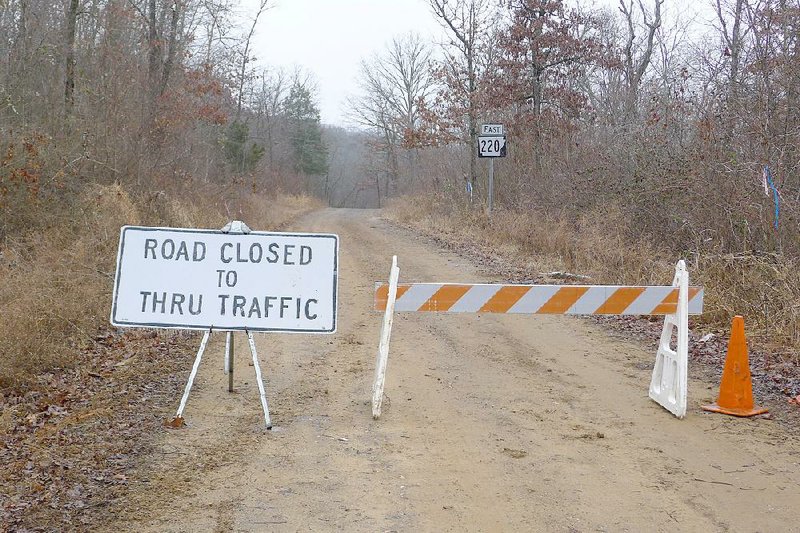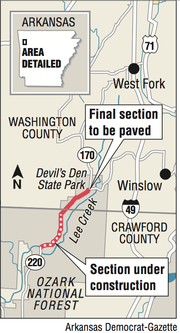WINSLOW — Work will begin next month to pave the last stretch of gravel highway in Arkansas.
The 3.87-mile segment of Arkansas 220 goes from Devil’s Den State Park south about a mile into Crawford County.
Arkansas has 16,411 miles of highways.
“Paving these last few miles is highly symbolic for a state which has traditionally had a reputation as hopelessly backward,” said Tom Dillard, an Arkansas historian.
Dillard cited the story of the Arkansas Traveler and the 1903 book On a Slow Train Through Arkansaw, which became the best-selling joke book in American history.
Thomas William Jackson, the book’s author, wrote that his train made so many stops in Arkansas, he asked the conductor what was wrong. The conductor said some cattle were on the track. Shortly afterward, the train stopped again and Jackson asked why.
The conductor said, “We have caught up with those cattle again.”
Throughout Arkansas’ history, said Dillard, “our state was viewed by much of America as lacking basic modern transportation infrastructure.”
The etymology of “Boston” in the name Boston Mountains implies as much.
“The name of the mountains is perhaps a corruption of a French phrase for ‘rough road,’ though other sources have noted that ‘a Boston’ was slang in the American West for any difficult task,” Margaret J. Guccione wrote for the Encyclopedia of Arkansas History & Culture.
The Boston Mountains are part of the Ozark Mountains in Arkansas.
ARKANSAS 220
Arkansas 220 is a one-lane dirt highway, with a smattering of gravel, through a remote section of the Ozark National Forest. Part of Arkansas 220 near Devil’s Den was still closed last week after heavy rains caused an earthen slide on Dec. 29. But it should be reopened soon, said Danny Straessle, a spokesman for the Arkansas Highway and Transportation Department.
The 3.87-mile paving project will include widening the highway to two lanes and building a bridge over Ellis Branch Creek. Pace Construction Co. of St. Louis was awarded a contract to do the $7.7 million job. The work should be completed next year, said Straessle.
Farther south in Crawford County, work began last year to widen and grade a 3.56-mile section of Arkansas 220 before paving it. A $4.5 million contract was awarded in April to Nabholz Construction Corp. of Conway to pave that segment and build a bridge over Falls Creek. That work should be completed late this year or early in 2017, Straessle said.
Grants from the Federal Lands Access Program will pay $9.5 million of the construction costs for both projects, said Randy Ort, a spokesman for the Highway Department.
“This was perfect,” Ort said. “You’ve got a highway through a national forest that qualifies for this grant program. I enjoyed driving the road when it was unpaved, and I’m sure I’ll enjoy it when it’s paved.”
A 7.43-mile section of Arkansas 220 is unpaved, but the southern 3.56-mile part should be paved before the rest, said Chad Adams, district engineer with the Highway Department’s District 4, which is based in Barling.
If efforts to pave all state highways sound familiar, it’s because Arkansas has been down this road before.
In 1985, the department set out to pave all state highways within a decade, and it was successful.
But then, in 1998, the Highway Department took ownership of the unpaved Arkansas 220, Ort said.
The road was originally owned by the U.S. Forest Service. Over time it became two county roads.
In 1997, the Highway Department announced plans to take over the county roads, pave them and rename the stretch as part of Arkansas 220, which continues south through Cedarville, then west through Uniontown to the Oklahoma border.
Back then, about 315 cars traveled the county roads daily. Last year, with construction underway, the number was 30 just south of the dirt work and 270 five miles farther south toward Cedarville.
Environmental studies were done in 1997 and reassessed in 2015. The Arkansas 220 construction projects are not likely to affect threatened or endangered bats in the area, according to the Highway Department and the U.S. Fish and Wildlife Service.
“There were no additional environmental impacts identified,” according to an Oct. 21 letter from John Fleming, head of the Highway Department’s environmental division, to the Federal Highway Administration.
DEVIL’S DEN
Cedarville Mayor Mark Isenhower said he’s happy to hear that Arkansas 220 will be paved.
“It brings you right in to Devil’s Den,” he said. “That would be awesome.”
According to Google Maps, Devil’s Den is 20 miles north of Cedarville via Arkansas 220. But it’s 42 miles from Cedarville on the next closest alternate route, which goes east through Rudy on Arkansas highways 348 and 282, north on Interstate 49 to Winslow, then west on Arkansas 74.
Ort said one of the things the Highway Department is supposed to do is provide access to state parks.
“If it is a paved route, I do think more people will utilize it,” he said of Arkansas 220 south of Devil’s Den. “People shy away from unpaved roads for obvious reasons.”
Monte Fuller, superintendent at Devil’s Den State Park, said a paved Arkansas 220 will provide better access for people driving from points south. According to Google Maps, the drive will be 10 miles shorter for people coming from Van Buren. But it may take the same amount of time because of the curvy road, Fuller said.
Fuller said visitors who use GPS or smartphone apps to find the park are sometimes surprised to find themselves on a rugged back road — the unpaved part of Arkansas 220.
“We’ve had people in motor homes, pull-type RVs, motorcycles — those guys are just creeping along because it’s such a rough road,” said Fuller. “It’s so remote back in that area, and there’s very limited cell service.”
Fuller said there are no houses along the 8-mile stretch of Arkansas 220 heading south from Devil’s Den.
Paving Arkansas 220 will open up the Ozark National Forest to more motorists and provide better access to the state park, Fuller said.
“It’s going to be a bygone era now that all the state highways are going to be paved,” he said. “Growing up in Arkansas, I remember several state highways that weren’t paved.”

